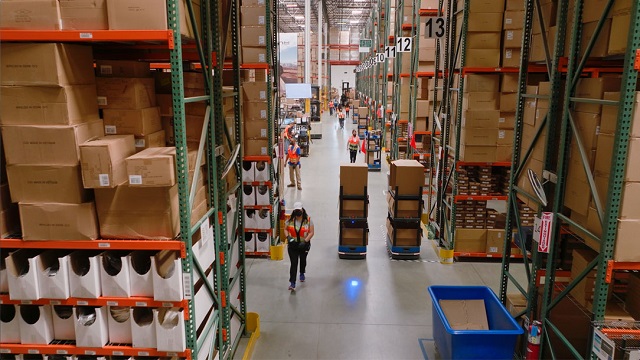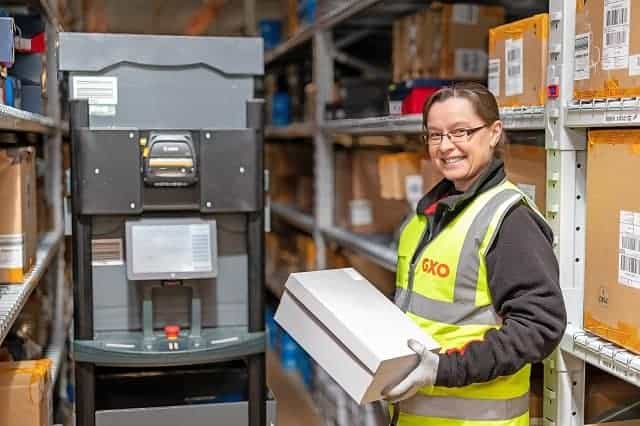Optimizing your warehouse means examining every corner of your infrastructure and every facet of your workflows and processes to identify and correct inefficiencies. Not only does warehouse optimization result in a healthier bottom line, but it also improves key warehouse metrics like accurate orders and on-time delivery.
Implementing the right technologies, such as collaborative mobile robots, can help to optimize resource management and improve productivity. After implementing Chuck by 6 River Systems, one leading 3PL doubled its pick rates and improved order accuracy to 99.9%. What’s more, the company reduced new hire training time by 10 days. Of course, warehouse optimization isn’t something you do just once; it’s an ongoing process, and a complex one at that. Warehouse operators must make smart technology investments and continuously evaluate warehouse systems and processes to adapt to changing market conditions.
To help you identify and address important components of warehouse optimization and warehouse space management, we’ve compiled a list of 50 expert warehouse space optimization tips and best practices, covering everything from warehouse layout optimization, to tools, to logistics and warehousing, to new technologies and software that support efficient operations. Click on a link below to browse tips and space optimization techniques related to a topic of interest:
- Tips for optimizing your warehouse layout & organization
- Tips for optimizing your warehouse workflows & processes
- Warehouse inventory optimization tips
- Optimizing your warehouse with tools & technology
Tips for optimizing your warehouse layout & organization
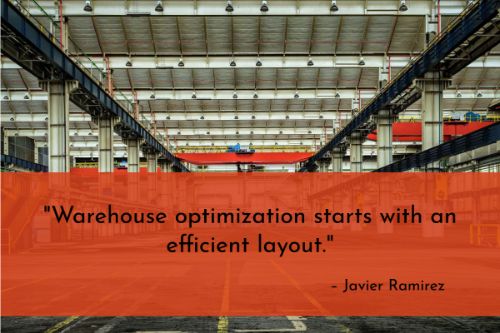
1. Design a floor plan that meets your needs now and also allows for growth. “Warehouse optimization starts with an efficient layout. Where is your picking operation located with respect to shipping and product storage? Is your floor space cluttered and aisle ways clogged? Are parts located far from your assembly operation? These indicators signal the need to develop a floor plan that combines complementary operations along with storage that meets needs now and provides room for growth.” – Javier Ramirez, Warehouse Optimization With the Right Equipment & Design, East Coast Storage Equipment Co.
2. Reduce travel time by storing the most frequently picked items in accessible locations. “The overall amount of time it takes for raw materials or parts to make their way through your warehouse and onto store shelves is another key metric in determining your success as a warehouse supervisor. Similar to velocity, proactive managers can reduce travel time by stocking important or frequently used parts in the most accessible areas. Products with tight shipping deadlines or time constraints should also be stacked in this manner, thereby streamlining movement and overall travel time even more.” – Megan Ray Nichols, Business Tip: Tips and Tricks for Warehouse Optimization, The Moderate Voice

3. Setup your quality control area as close as possible to the packaging area. “The QC process is the last and most important phase of the order preparation process. It is imperative that items remain free from contamination or unnecessary handling before they are packaged. When the QC station is right next to the packaging area, the likelihood of contamination is greatly reduced.” – Emma Sturgis, 10 Great Warehouse Optimization Tips for Small Businesses, Fishbowl Inventory
4. Reclaim your floor space using the 5S method: sort, set in order, shine, standardize and systematize. “If your warehouse has been in operation for many years, ‘stuff’ has a way of accumulating in places that should be used for valuable inventory and stock.
“We recommend the 5S process popularized by ‘The Toyota Way’ to reclaim floor space. Once you reclaim your floor space, go vertical for increased storage density.” – Cody Adams, 13 Tips for Your Ultimate Warehouse Design & Layout, Formaspace; Twitter: @Formaspacecom
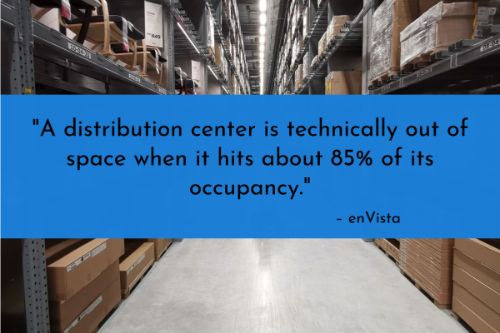
5. Strive for 85% occupancy to avoid congestion. “A distribution center is technically out of space when it hits about 85% of its occupancy. That’s not just in the storage area; it holds true for receiving, shipping and all other process areas.
“What happens when a distribution center goes beyond the 85% limit? The biggest problem is congestion. Congestion causes extra work – meaning extra work by moving product that you don’t have room for. You have to move ‘Product A’ into another location in order to take this other ‘Product B’ out. You start to store stuff in aisles. You use staging space that’s typically free space for new incoming material.
“Think of it as a three-car garage. If you put all three cars in a three-car garage, you have no room for lawn mowers, snow blowers or yard tools, and you have to move a car out in order for them to fit. The same thing happens in a distribution center. If it’s jam-packed full, you’re typically moving inventory in and out, and you’re taking up valuable time and additional labor.” – How to Maximize Warehouse Space Utilization Without Expansion, enVista; Twitter: @enVistaCommerce
6. Ensure that bin and container space is consistent with the items being stored. “One area that is often overlooked when warehouse space is not an issue, is to ensure that the warehouse space is consistent with the items to be stored. For example, if a finished good is packaged in a container 3 feet by 3 feet, then the area where the item is stored should reflect that size. If the rack of bin location was designed to accept 4 feet by 4 feet box, then there is a lot of empty space when a 3-foot square box is placed there. By making sure that the bin location is suitable for the item, the change can free up space in the warehouse, and the company is no longer paying money to store air around an item.
“Another area that can maximize space utilization is to use containers in the warehouse that fits the item that is being stored. Quite often, a part is not packaged and will need to be placed in a storage container before it is stored on the racks. Many warehouses do not have various sizes of these storage containers and adopt a “one size fits all” approach. This means that a replacement valve for a pump can be placed in the same size container as a few yards of PVC piping. The pump may fill the container 85 percent, while the piping barely takes up ten percent of the container.” – Martin Murray, How to Maximize Your Warehouse Space Utilization, The Balance; Twitter: @thebalance

7. Optimize aisle width. “Floor space in a warehouse is almost always defined by the aisles that house the stock. If your aisles aren’t properly optimized, this could be costly to your operation. It’s simple: removing wasted space from the equation allows you to increase the number of aisles and therefore the number of pallet racks, which means you can house more overall stock. Depending on the size of the racks and products you stock, reducing the aisle width from 12 to 6 feet could increase your storage space by up to 50 percent.
“When determining the optimum aisle width, there are a few factors to consider. The forklifts you use can be the biggest hurdles to narrower aisles, as larger models may not fit comfortably into the reduced space or have enough room to carry out processes properly. You must also think about any floor staff who might be in the aisles. It’s for this reason that the optimum aisle width will be different for each operation. Be sure to accurately measure the dimensions in your warehouse and think through the different aspects that need to fit into each aisle.” – Simon Mitchell, 4 Ways to Maximize Your Available Warehouse Space, Reliable Plant; Twitter: @NoriaCorp
8. Set hard boundaries for each zone. “Bigger warehouses have the luxury of being a little more flexible with their zone usage, devoting more space to areas, or even having a little unused space – smaller warehouses, however, can’t really go for that option. When organizing or remodeling your warehouse, make sure to set hard and fast boundaries for each zone to make the most of your space and prevent any needed operations from getting crowded out.” – Optimization Practices For Smaller Warehouses, Shelving.com; Twitter: @ShelvingDotCom
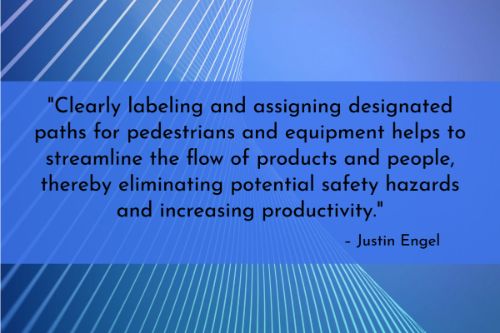
9. Use clear signage and labels to facilitate efficient navigation. “Without the proper organization, a warehouse operation is likely to become chaotic and counterproductive, so it’s important that all employees know where and when they should be at all times. Begin this process by posting proper signage throughout your warehouse to help pedestrian and equipment operators navigate the warehouse in a safe and efficient manner. Clearly labeling and assigning designated paths for pedestrians and equipment helps to streamline the flow of products and people, thereby eliminating potential safety hazards and increasing productivity.” – Justin Engel, Easy to Implement Warehouse Optimization Tips, Starke; Twitter: @StarkeMH
10. Consider revamping your racks for additional space. “Racking is the first thing to be considered for warehouse space optimization. But just before going for a rack revamp, consider the following idea that actually determines whether your attempt will be worthy enough to earn the additional space you are longing for.
“Make a note of every rack elevation and the pallet heights. An ideal arrangement will have 4 to 6 inches of gap between the top of the pallet and the base area of the beam for forklifts to operate easily. If your racks have more space than that, then you’ve found your opportunity for the additional space. Of course, there are other factors to be taken into consideration before going for a space revamp like forklift operating height, fire safety precautionary space, etc.” – Meena, Maximizing Warehouse Space Without Adding a Single Piece of Real Estate, Contalog; Twitter: @ContalogApp
Tips for optimizing your warehouse workflows & processes
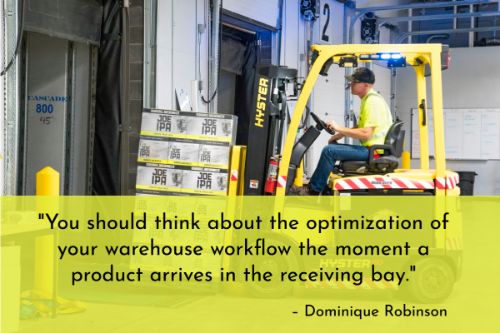
11. Optimization starts with receiving. “You should think about the optimization of your warehouse workflow the moment a product arrives in the receiving bay. When that product order arrives, it’s officially a part of your warehouse. Once received, products are checked for damages, mis-picks, and quantity. It’s important to give employees plenty of space to remove inventory from pallets and perform other duties.” – Dominique Robinson, How to Optimize Your Warehouse (and Grow Your Business), SkuVault; Twitter: @skuvault
12. Standardize your processes. “Do this by reducing potential variation in areas such as unloading, accounts payable, shift scheduling, and facilities management. Standardization saves time and money and reduces errors.” – Jason Minghini, Top 10 Steps To Efficient & Productive Warehouse Optimization, Kenco; Twitter: @KencoGroup

13. Partner with several shipping providers to provide your customers with shipping options. “It doesn’t matter how fast and efficient your picking and packing process is if your shipping provider can’t keep up. It pays to have connections with multiple providers, so you can offer your customers the best price on a variety of shipping speeds. Plus, if one of your providers falls through, you’ll always have a backup, so you don’t risk losing a sale. When it comes to optimizing your shipping process, have a designated shipping station so orders can be picked up, scanned in, and shipped out quickly all in one place.” – How To Optimize Your Warehouse Layout, ShipHero; Twitter: @weareshiphero
14. Know your staffing requirements. “It is vital to develop a spreadsheet of the required number of employees categorized by type of position and level of training, management level, and the shift schedule. This data should be analyzed to help determine the best design and equipment allocations for your warehouse. The management staff should be familiarized with warehouse management software and inventory control aids. Health and safety standards should dictate elements of equipment allocation and design as necessary.” – 6 Warehouse Optimization Tips for Finding the Right Equipment and Design, Michaels Global Trading; Twitter: @MichaelsTrading
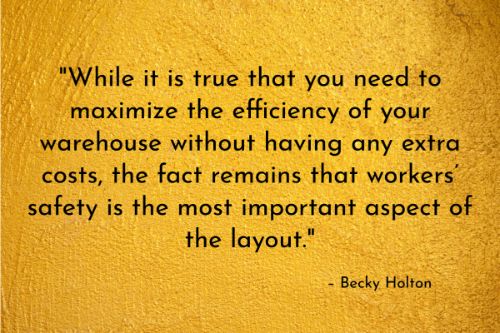
15. Keep safety in mind. “While it is true that you need to maximize the efficiency of your warehouse without having any extra costs, the fact remains that workers’ safety is the most important aspect of the layout. Let it be your number one priority by respecting security standards and preventing possible injuries. Leave enough room between palette places for both your employees and forklifts. Be careful with dock edges, slots, and bins because they are all critical points where most incidents occur.” – Becky Holton, Tips When Designing a Space-Efficient and Productive New Warehouse, REoptimizer; Twitter: @REoptimizer
16. Train your staff on how to handle different materials, tools and equipment. “It is important for the entire warehouse staff to have a good understanding of how to handle different materials, goods and equipment like conveyors in material handling. Display tips for handling material safely in different locations around the warehouse, which the workers can refer to in case of queries. Arrange training sessions where the workers can learn how to use the right tools for various material handling jobs and the right ways of handling different types of goods.” – 7 Tips to Improve Warehouse Material Handling Practices, Modern Materials Handling; Twitter: @modernmhmag

17. Make note of unused space for later use. “If some of the storage racks in your warehouse are going unused or underfilled, make a note of that space, and what items are near it in your planogram (floor/rack schematics). Using these notations of your used and unused space, you can plan around the arrival of new products in your warehouse—rearranging your storage so that new products can be slotted in with ease.” – 9 Easy Tips for Maximizing Your Warehouse Storage & Operations, Southern States; Twitter: @states_southern
18. Consider a multi-order picking process. “One of the most efficient ways to increase picking speed is a multi-order picking process. There is a variety of picking methods to suit different workflows. A few pickers can work on one order, or one picker can pick many orders in one pass. Orders can be picked by a certain delivery date, during shifts and so on.” – Overview of picking optimization methods for your warehouse, VentorTech; Twitter: @ventor_tech

19. Measure travel time. “Some companies believe that more space means better storage, but that’s not always the case. Gonzales points to another customer that moved from a 25,000- to a 100,000-square-foot warehouse. ‘They had six employees in the warehouse and planned to use the added space to store more products. On average, 55 percent of an employee’s time is spent traveling on foot or by forklift, so they were doubling or even tripling their travel time,’ he says. Depending on the size of the warehouse, the work performed and the way items are found, managers should consider instituting a method of measuring travel within the warehouse, which will identify areas for improvement. Reducing travel time leads to improved productivity in getting orders out faster and more efficiently without overtaxing your labor force.” – 4 ways to optimize your warehouse layout, UPS; Twitter: @UPS
20. Eliminate non-value-added activities. “Warehouse resource optimization is all about the efficiency of the people. There are about 10+ measurements on evaluating the efficiency, but all those get consolidated to a single metric called the ‘LPMH’ (lines per man hour). Efficiency is achieved through eliminating non-value-added activities. There are multiple methods available including the Theory of Constraints (TOC), Waste Analysis, Therblig Study, VSM (Value Stream Mapping), GEMBA Study, Spaghetti Map, etc. These techniques are used depending on the type of problem/requirement and used as stand-alone or as a combination.” – Alvis Lazarus, Warehouse Optimization – A COMPETITIVE EDGE in Supply Chain!, LinkedIn; Twitter: @AlvisLazarusA

21. Outsourcing systems or operations can help warehouses handle spikes in demand. “Sometimes, third-party fulfillment or partnerships can help handle surges in operation. Outsourcing can include utilizing software-as-a-service (SaaS) systems or working directly with third parties to increase your resources, such as temporary laborers or equipment.
“If outsourcing any labor resources, remember to give proper training and orientation to your facility. Proper training reduces delays caused by temporary workers not understanding how your facility runs. Furthermore, conduct routine meetings with temporary laborers, in addition to regular staff meetings with internal staff, to ensure consistency and better collaboration on the warehouse floor. You may also use a labor management software to track both internal and external staff performance.” – 5 Tips for Warehouse and Distribution Center Management Success, FDL Group
22. Analyze your supply chain performance regularly to adapt to changing market conditions. “Supply chains are no longer ‘set it and forget it.’ They are living, breathing organisms that evolve as business strategies, market conditions, product line performance and other variables change. A good supply chain must be able to adapt to whatever happens in the marketplace.
“The first step in optimizing and building a world-class supply chain is to map out your current supply network.
“For that, a lot of data gathering and analysis is required. Because you’re trying to get a complete picture, you should not only look at data strictly on a supply chain-related basis but also include things like warehouse workers’ salaries and their hours as they play a significant part in the cost structure of supply chains.” – Aaron Orendorff, Supply Chain Optimization: How to Develop a World-Class Logistics Network, ShopifyPlus; Twitter: @ShopifyPlus
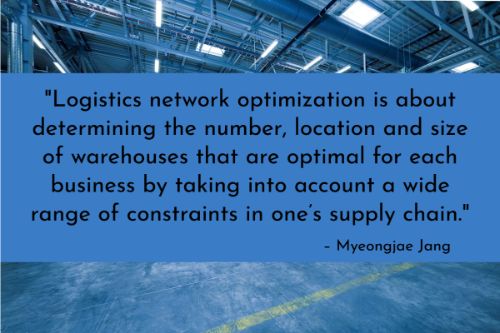
23. Optimize your logistics network. “Logistics network optimization is about determining the number, location and size of warehouses that are optimal for each business by taking into account a wide range of constraints in one’s supply chain. In other words, it is to find the best combination of warehouses necessary to cover the entire supply chain from raw material suppliers to end-users.
“Logistics takes place largely in three areas – procurement, supply and sales. Typically, logistics network optimization is for supply and sales of finished goods, although it sometimes includes sourcing of parts or raw materials. In the end, logistics network optimization aims to find an optimal combination of various warehouses best suited to the client’s needs.” – Myeongjae Jang, Understanding of Logistics Network Optimization – Why and How to Optimize a Logistics Network?, Samsung SDS; Twitter: @SamsungSDSA
24. Develop systems to double-check accuracy at pick locations. “Design your order picking strategy so that each step of the order picking process is double checked. Humans are imperfect, and so your staff will make errors. To avoid this, it is smart to double-check (and even triple-check) to eradicate mistakes. Ideally, you’ll want the errors to be caught while the order picker is in place at the pick slot. If this error catch is successful at this point, it eliminates any cost associated with the mistake.” – Order picking strategies for a warehouse, Warehouse IQ; Twitter: @WarehouseIQ

25. Implement a quality control (QC) process. “When it comes to order management, packers typically don’t inspect products before they package them. It’s more about the speed at that point. While speed is essential, quality is absolute. Have a quality control process that is tight; assign QC personnel to your pickers to inspect items as they select them from shelves. If your budget doesn’t allow that, then ensure that those who pick check quality to make sure that every packed and shipped product passed QC.
“Regardless of the QC you have before packing, there should be one or two ways to ensure that products aren’t damaged in between packing and the customer. Doing this removes most fulfillment roadblocks that might negatively affect your reputation.
“The QC process also needs to be fast and updated real time. The faster you are aware of damaged goods, the quicker you can resolve them. If they are not updated real-time, your system will show products as available on the shelves when they are not good enough to move.” – Darren DeMatas, How To Scale Operations With Ecommerce Warehouse Management, ShipStation; Twitter: @ShipStation
26. Ensure that delivery windows, returns process and returns timelines are in line with the rest of the industry. “Whether it’s off-the-shelf or personalized, customers simply don’t want to wait a long time for their orders to manifest, and a warehouse is the first — and often only! — line of defense against that impatience. Make sure that your delivery windows are in line with the rest of your industry and don’t neglect reverse logistics. Your return process and timeline should be just as short and hassle-free as that of your ordering process. If an order goes off without obstacles but the return process is a headache, a customer won’t remember your stellar delivery, they’ll remember the aggravation of attempting to return their incorrect or damaged product.” – The Essential KPIs You Need to Measure Your Warehousing Efficiency, Aero Fulfillment; Twitter: @AeroFulfillment
Warehouse inventory optimization tips

27. A good inventory management strategy benefits the bottom line. “Inventory management can have real-time and monetary benefits. By keeping track of which products you have on-hand or ordered, you save yourself the effort of having to do an inventory recount to ensure your records are accurate. A good inventory management strategy also helps you save money that could otherwise be wasted on slow-moving products.” – Top Five Benefits of a Good Inventory Management Strategy, Scanco; Twitter: @ScancoLLC
28. Know which inventory items are fast-, medium- and slow-movers. “The primary objectives of a warehouse are to use space discriminately, allow for the most efficient material handling, relatively provide the most economical means of storage in respect to costs of equipment, use of space, damage to material, handling labor and operational safety as well as provide greater flexibility in order to tolerate changing storage and handling requirements. Which brings us to the Pareto principle that states that 80% of the activity in a warehouse comes from 20% of the items, and these items are the fast-movers within the warehouse.
“The next 15% of the activity comes from 30% of the items, which are medium-movers. Finally, 5% of warehouse activity comes from 50% of the items, which are slow-movers. Understanding this principle gives the warehouse manager insight into managing inventories and utilizing space even when problems such as booming business and obsolete inventory which causes congestion arises.” – Warehouse Space Optimization: 17 Tactics That Can Be Used to Improve Space, SCMDOJO; Twitter: @muddassirism

29. Use slotting to minimize inventory loss. “Slotting helps ensure proper product handling. Items are placed neatly and properly for pickup and are easy to locate, so handling improves greatly. If the items are not stored properly, then you may eventually either damage them or delay their shipping. For example, if perishable items are not stored properly in their designated and facilitated slots, then they may be expired when their picking time arrives.” – Jules, Slotting: 5 Tips to Optimize Your Warehouse for Efficiency, Easyship; Twitter: @goeasyship
30. Consider dynamic slotting for greater flexibility. “Dynamic slotting is a new term and yet to get standardized. It means that the WMS has the ability to set up new or impermanent slots for items allocated for known shipments. So, if a warehouse team knows they are going to have a high proportion of picks for a specific item, they may choose to create a new temporary slot right by the picking/shipping area rather than sending the picker to the normal slot.” – Madhusudhan Ranjanghatmuralidhar, 10 Advantages of Slotting Optimization in Warehouses, HCL Technologies Limited

31. Re-slot pick positions as often as necessary. “Up to 60% of a picker’s daily activity can be involved in travel time (afoot or on a forklift or walkie), so reducing that time-spend is an excellent idea. A good product slotting strategy can reduce travel time thereby reducing picking labor. Always weigh the time and cost of a complete re-slot against the costs of it. Busy operations re-slot their fast moving, high-profit SKU’s every day. Slotting the facility once and leaving it that way for years is typically a recipe for wasted time and money.” – Scott Stone, 13 Best Practices for Warehouse Productivity, Cisco-Eagle; Twitter: @CiscoEagle
32. Use a bin locator system to make products easy to locate. “You cannot merely keep different types of cargo anywhere in the warehouse, and then expect your staff to find it whenever needed. To organize your warehouse efficiently, you can bin locate your cargos. It refers to a designated inventory storage location system, where you mark all the rows, columns and racks. When you keep a particular product in one of these locations, the specific row, column and rack become the bin number for that type of product. The format of the bin number is entirely your decision.
“Your staff needs to understand the bin locator concept, and accordingly organize your warehouse. If all the cargos are stacked as per their bin numbers, and all this information is fed into a digital portal, any new employee can find any product that you want in your warehouse. It also reduces the number of steps that your employee needs to take to find the product, going through all the ones stacked at the top; reducing wastage of time and futile efforts.” – Bill Dunn, Top 5 Tips To Optimize Your Warehouse Storage System, Cerasis; Twitter: @Cerasis
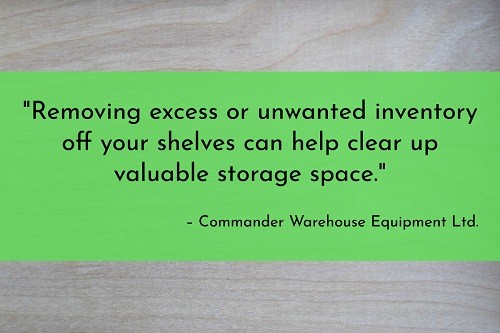
33. Remove excess or unwanted inventory. “Removing excess or unwanted inventory off your shelves can help clear up valuable storage space. Consider reassessing your sales projections to ensure that you are maintaining the optimum level of inventory to help cut down on additional stock. It might also be a good idea to look at the stock items that do not perform well and removing them from your inventory.” – Warehouse Space Optimization Techniques, Commander Warehouse Equipment Ltd.
34. Establish par levels. “The first thing you should do is establish par levels of your products, which are the minimum amount of product that must be on hand at all times.
“You know it’s time to order more when your stock dips below that predetermined level, which will vary by product. These levels are based on how quickly the item sells and how long it takes to get back in stock, and in a perfect world, you will order the minimum quantity that will get you back above par — eliminating excess stock while preventing a lack of in-demand product.
“While establishing par levels can take a little bit of research and up-front work, having them set will systematize the process of ordering and help you make quicker decisions. Remember that things can change over time, so check your par levels throughout the year and make any necessary adjustments.” – Abby Heugel, Follow These 8 Inventory Control Methods to Keep Your Store in Top Shape, VendHQ; Twitter: @vendhq

35. Implement inventory cycle counts. “Adopting cycle counting eliminates the need for full-scale inventory audits, reducing costs significantly. Frequent counts also improve the accuracy of inventory records, often to levels of 97% and above. Armed with accurate information, staff can quickly and confidently determine the availability of products, resulting in fewer embarrassing errors, timely reordering and a more streamlined customer experience.
“A further benefit is that cycle counting requires a well-organized stockroom. The most effective cycle counting techniques utilize a variant of ABC analysis, which divides your stock according to its value – based on cost, sales volume, margins or some other metric. Once your stock is divided in this way, goods can be organized according to their importance; for instance, items with the highest turnover could be placed in an easily accessible location.” – 10 Tips to Improve Your Retail Stockroom, Action Storage; Twitter: @ActionStorage
36. Implement the first-in, first out (FIFO) inventory control method. “If you haven’t already, it is absolutely critical that you implement ‘first-in, first-out’ as a standardized practice in your fulfillment and inventory management operations. This refers to ensuring that your oldest stock is always shipped first, not the newest stock. Obviously, this is most important when we are talking about perishable products or any product with an expiration date.
“First-in, first-out is also important for non-perishable products as well. Over time, unsold items will have wear and tear from being jostled around in storage. The packaging and design can fade or change over time. You don’t want to end up with products that have been sitting in the back of storage for so long that they are unsellable.” – Luke Metcalfe, eCommerce Inventory Optimization Tips — How to Use Data to Buy and Sell the Right Products, Crealytics; Twitter: @crealytics

37. Develop effective inventory replenishment practices. “Effective inventory replenishment requires careful planning using demand forecasting, inventory analysis (i.e., loss due to damage or going bad) and other supply chain metrics such as in-stock status and product velocity (the rate at which an SKU sells).
“The key is to find the sweet spot where you have enough inventory to meet demand (without the risk of stockouts), while also avoiding overstocking items that either won’t sell at all or won’t sell fast enough to maximize your profits.” – Chris Dunakin, 4 inventory replenishment methods, 6 River Systems; Twitter: @6riversystems
Optimizing your warehouse with tools & technology
38. Take advantage of warehouse analytics and forecasting tools. “As a warehouse manager, you’ve never had more tools at your disposal for diving deep into the ebb and flow of your operation. We collect data from every corner of the enterprise — but do we know which data is most important? Are we putting all this analytical potential to good use?
“Analytics platforms for warehouses can help business owners forecast customer demand over time. In turn, this can help optimize the allocation of labor over an operational period and avoid over- or under-purchasing key merchandise or materials.” – Megan Ray Nichols, Warehouse Optimization Tips You Need to Know, All Things Supply Chain; Twitter: @ATSCblog
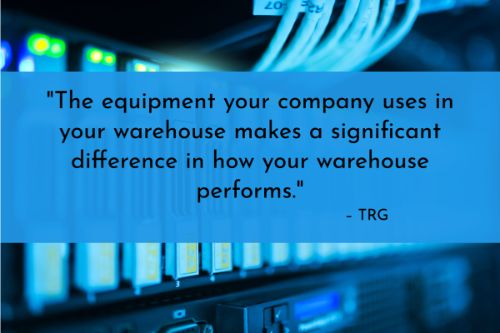
39. Upgrade your warehouse equipment. “The equipment your company uses in your warehouse makes a significant difference in how your warehouse performs. While you may already have a fair amount of equipment in use, consider the current performance and age of that equipment. Is it still performing to specification? Are employees using that equipment experiencing any issues? Does that equipment still provide business value?
“If you have any doubts about your equipment in these areas, it may be time to upgrade or even outright replace them. The advantages of upgrading include better security (which should always be a top priority), faster performance, better ergonomics for warehouse employees, as well as better compatibility with operating systems that allow certain functions to be done on mobile devices. Wearables are a great example of an equipment upgrade that might be useful to your organization in this area.” – 5 Tips for Effective Warehouse Optimization Using Technology, Technology Recovery Group; Twitter: @TRG_Solutions
40. Think beyond forecasting at the SKU level. “You should periodically review the current forecast level. Is it still appropriate for your goals? For example: forecasting at SKU level may not be enough. You might need to use greater detail by forecasting by sales region or channel.” – 17 Practical Warehouse Organization Tips to Improve Efficiency in 2019, Conger; Twitter: @Conger1
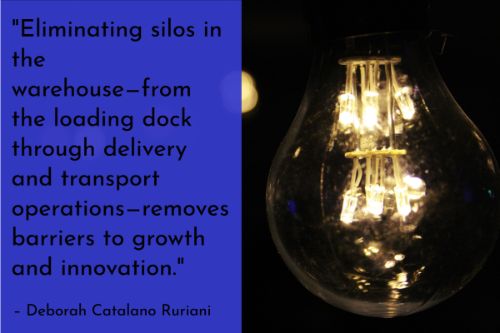
41. Eliminate information silos within your warehouse. “Eliminating silos in the warehouse—from the loading dock through delivery and transport operations—removes barriers to growth and innovation. In many organizations, supply chain executives and corporate operations plan independently, often negatively impacting corporate goals. Maximize profits and establish competitive advantage with cross-functional organizational plans.” – Deborah Catalano Ruriani, Optimizing Warehouse Operations, Inbound Logistics; Twitter: @ILMagazine
42. Monitor key performance metrics. “After implementing new processes and technologies, you need to measure and review your warehouse performance to ensure that they have a great impact on the productivity of your warehouse. Here are some warehouse performance metrics that you should actively monitor:
“Order Fill Rate: The percentage of items ordered from the amount of inventory on hand. This is also known as demand satisfaction rate.
“Order Picking Accuracy: The percentage of orders picked without errors both from choosing the product and the quantity.
“On-Time Shipment to Customer: Percentage of orders sent on the requested or specified date. Successful retail companies usually have a level of timeliness of 97% or higher.
“Warehouse Capacity: The physical and actual capacity of the warehouse area used for inventory storage.
“Once you have succeeded in measuring the results of the new processes and technologies that you are implementing, you will be able to understand how and where you can continue to improve the efficiency and productivity of your warehouse.” – Kanya, How Retailers Can Optimize Warehouse Management & Improve Fulfillment, BusinessTech by HashMicro; Twitter: @HashMicro
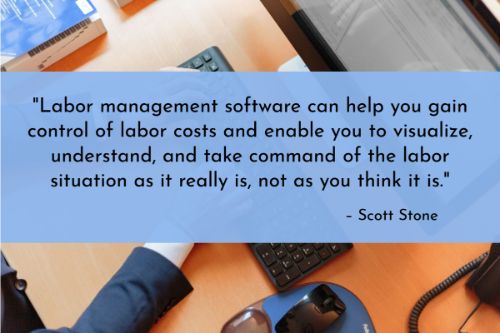
43. Use labor management tools to optimize performance. “Labor management software can help you gain control of labor costs and enable you to visualize, understand, and take command of the labor situation as it really is, not as you think it is. Handling labor resources correctly can be the difference between an adequate operation and a good one…or a good one vs. a great one. These tools are best applied in high-volume picks, not for bulk items where heavy machinery is required to deal with stock.” – Scott Stone, 13 Best Practices for Warehouse Productivity, Cisco-Eagle; Twitter: @CiscoEagle
44. Automate the receiving process with warehouse management software to reduce errors. “There are two ways for receiving products: manual and automated. In the manual checking process, an employee looks over a shipping invoice and visually checks that everything listed has arrived and has the right quantity. This method is cheaper, but it increases the chance of human error. For that reason, in many cases, double-checks are required which increase your company’s expenditure. By automating this process with a warehouse management software, you’ll reduce errors and save time and money. Using automation software, by simply scanning product barcodes you will upload all the information to your server.” – 5 steps to optimize your warehouse operations, DataScope

45. Use barcodes or QR codes to simplify data collection and auditing. “The ability of an application to scan a QR code or barcode can significantly simplify some vital processes during a warehouse audit. For example, this technology keeps a record of the important information such as equipment breakage history.” – Daria R., Choosing the Best Technologies for Warehouse Optimization, Cleveroad; Twitter: @cleveroad
46. Leverage technology to work smarter, not harder. “Distribution center management technologies have advanced light years beyond the standard, pencil-and-paper tracking. Modern technologies can automatically identify products, reorder product and much more. However, it is up to warehouse managers to implement and use these technologies to work smarter, not harder. Additionally, robotics can help reduce the workload on employees.
“Meanwhile, new systems can provide better benchmarking and management of overall systems. Peaks in warehouse operations, especially during the holiday season, can increase nine-fold. This means every aspect must be managed and controlled.” – 5 Tips for Warehouse and Distribution Center Management Success, FDL Group

47. Use integrated solutions to support automated data transfer. “Integration is important because of the large amount of data that must be considered by logistics optimization. For example, optimizing deliveries from a warehouse to stores each day requires data regarding the orders, customers, trucks, drivers, and roads. Manually entering anything other than very minor amounts of data is both too time consuming and too error prone to support optimization.” – H. Donald Ratliff, Ph.D., 10 Rules for Supply Chain & Logistics Optimization, Supply Chain 24/7; Twitter: @SupplyChain247
48. Identify peaks in warehouse capacity. “Throughout the year, warehouses experience changes in capacity due to increases and decreases in consumer spending. For example, shipping during the holiday season tends to increase as more people begin purchasing items online for gifts. However, distribution centers cannot possibly foretell how much of a specific product needs to be available unless the distribution center management has previous accounts of how much product has typically been required during similar time periods. This is where the metric of monitoring warehouse capacity and peak volume comes into play. Appropriate warehouse tracking must include monitoring of peaks in capacity.” – Adam Robinson, The Most Important Distribution Center Metrics to Track and Understand, Cerasis; Twitter: @Cerasis

49. Use an order management system to streamline the packing process. “The challenge in the packing process is to use the right size and least number of boxes to complete each order in such a way that shipping costs are minimized, and to use the right kind of packing materials to ensure that orders arrive in good condition. An order management system can be used to meet these challenges: the order management system maintains information regarding each item’s size and weight, and the best type of packaging material is assigned to each item. When orders are filled, the order management system analyzes the order and automatically selects the proper packaging that will keep down freight cost, keep damage to a minimum, and take the least amount of time to complete the order.” – Monica Orrigo, How to Drive more Efficiency From Your Pick and Pack Process, Handshake; Twitter: @handshake
50. Leverage collaborative mobile robots to boost productivity and reduce errors. “Human error can be costly for a warehouse. Sending the wrong order can hurt customer relationships and increase return rates and refund requests. All of this can ultimately hurt your bottom line.
“Designed to leverage AI and machine learning, collaborative robots can make rapid decisions and help associates more efficiently manage multiple tasks during a single trip to the warehouse floor. And because collaborative robots are guiding your associates through tasks, they also minimize the likelihood of human error.” – John Gomez, 6 ways collaborative robots are transforming warehousing, 6 River Systems; Twitter: @6riversystems
Watch our webinar, ‘Building The Business Case for Cobots: The ACT Fulfillment Story,’ to learn how one 3PL tripled its pick rates with collaborative robots. We can also discuss the solution that’s right for you. Contact us today.

